Biermann Ch. Handbook of Pulping and Papermaking
Подождите немного. Документ загружается.

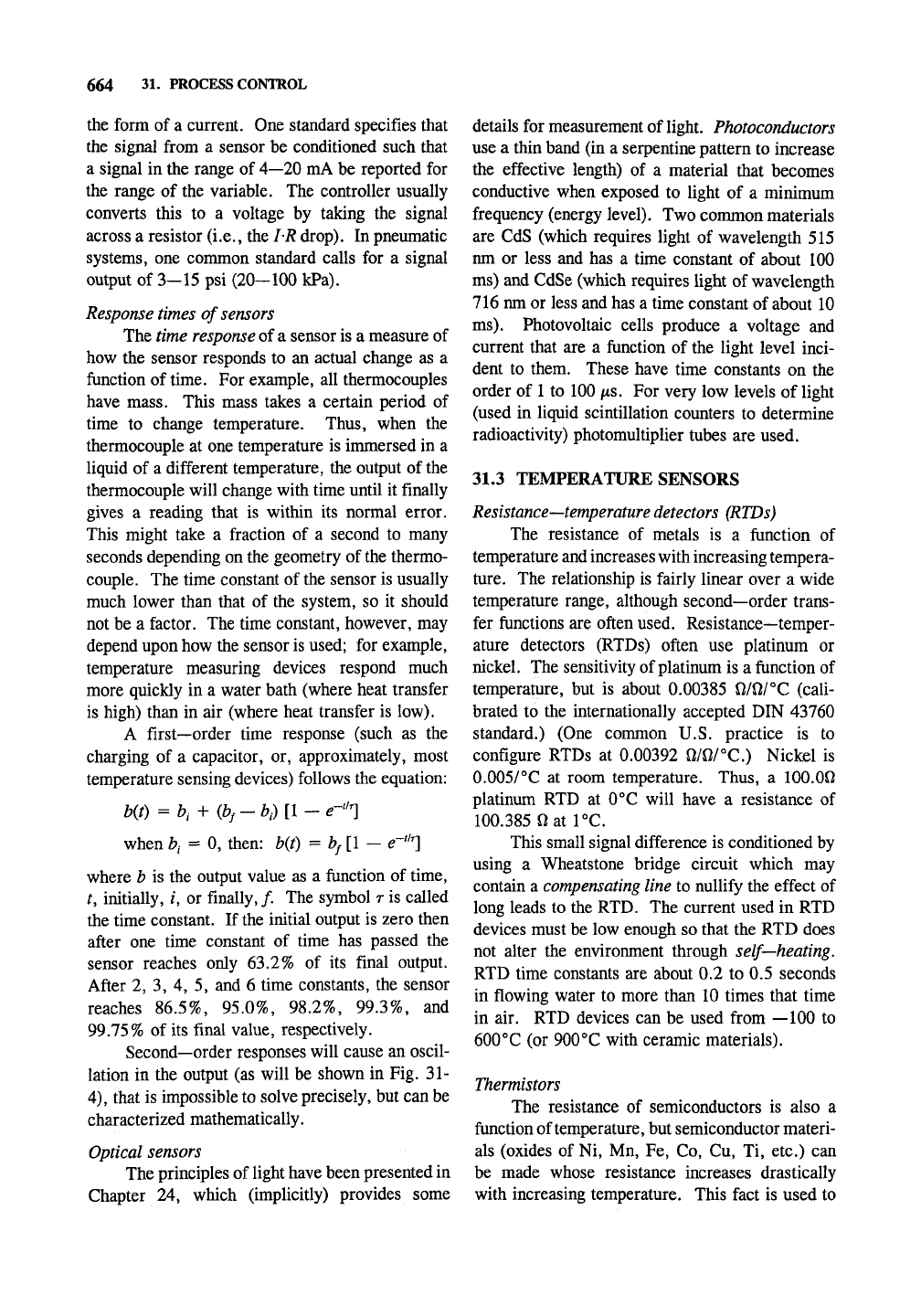
664 31. PROCESS CONTROL
the form of a current. One standard specifies that
the signal from a sensor be conditioned such that
a signal in the range of 4—20 mA be reported for
the range of the variable. The controller usually
converts this to a voltage by taking the signal
across a resistor (i.e., the IR drop). In pneumatic
systems, one common standard calls for a signal
output of 3—15 psi (20-100 kPa).
Response times of sensors
The time
response
of a sensor is a measure of
how the sensor responds to an actual change as a
function of
time.
For example, all thermocouples
have mass. This mass takes a certain period of
time to change temperature. Thus, when the
thermocouple at one temperature is immersed in a
liquid of a different temperature, the output of the
thermocouple will change with time until it finally
gives a reading that is within its normal error.
This might take a fraction of a second to many
seconds depending on the geometry of
the
thermo-
couple. The time constant of the sensor is usually
much lower than that of the system, so it should
not be a factor. The time constant, however, may
depend upon how the sensor is used; for example,
temperature measuring devices respond much
more quickly in a water bath (where heat transfer
is high) than in air (where heat transfer is low).
A first—order time response (such as the
charging of a capacitor, or, approximately, most
temperature sensing devices) follows the equation:
when
b^
= 0, then: b{t) = bf[l - e-'"]
where b is the output value as a function of time,
r, initially, /, or finally, /. The symbol r is called
the time constant. If the initial output is zero then
after one time constant of time has passed the
sensor reaches only 63.2% of its final output.
After 2, 3, 4, 5, and 6 time constants, the sensor
reaches
86.5%,
95.0%, 98.2%,
99.3%,
and
99.75%
of its final value, respectively.
Second—order responses will cause an oscil-
lation in the output (as will be shown in Fig. 31-
4),
that is impossible to solve precisely, but can be
characterized mathematically.
Optical sensors
The principles of light have been presented in
Chapter 24, which (implicitly) provides some
details for measurement of
light.
Photoconductors
use a thin band (in a serpentine pattern to increase
the effective length) of a material that becomes
conductive when exposed to light of a minimum
frequency (energy level). Two common materials
are CdS (which requires light of wavelength 515
nm or less and has a time constant of about 100
ms) and CdSe (which requires light of wavelength
716 nm or less and has a time constant of about 10
ms).
Photovoltaic cells produce a voltage and
current that are a fimction of the light level inci-
dent to them. These have time constants on the
order of
1
to 100 /xs. For very low levels of light
(used in liquid scintillation counters to determine
radioactivity) photomultiplier tubes are used.
31.3 TEMPERATURE SENSORS
Resistance—temperature detectors
(RTDs)
The resistance of metals is a fimction of
temperature and increases with increasing tempera-
ture.
The relationship is fairly linear over a wide
temperature range, although second—order trans-
fer functions are often used. Resistance—temper-
ature detectors (RTDs) often use platinum or
nickel. The sensitivity of platinum is a function of
temperature, but is about 0.00385 QIWC (cali-
brated to the internationally accepted DIN 43760
standard.) (One common U.S. practice is to
configure RTDs at 0.00392 0/0/°C.) Nickel is
0.005/°C at room temperature. Thus, a 100.00
platinum RTD at 0°C will have a resistance of
100.385
12
at rC.
This small signal difference is conditioned by
using a Wheatstone bridge circuit which may
contain a
compensating
line to nullify the effect of
long leads to the RTD. The current used in RTD
devices must be low enough so that the RTD does
not alter the environment through self—heating.
RTD time constants are about 0.2 to 0.5 seconds
in flowing water to more than 10 times that time
in air. RTD devices can be used from —100 to
600°C (or 900°C with ceramic materials).
Thermistors
The resistance of semiconductors is also a
function of temperature, but semiconductor materi-
als (oxides of Ni, Mn, Fe, Co, Cu, Ti, etc.) can
be made whose resistance increases drastically
with increasing temperature. This fact is used to

TEMPERATURE SENSORS 665
Metal 1
Metal 1
Reference
Junction
Metal 2
Measuring
Junction "v'
Fig. 31-1. Diagram of a thermocouple where V
is the voltage generated by the circuit.
make thermistors. High sensitivities of 0.1
Q/Q/°C (or 30 mV/°C) are possible. Typically,
an uncoated thermistor has a time constant of 10
seconds in air and 1 second in air. Coating with
Teflon will increase these values by 2.5 x. They
are used in the range of —50° to 150°C. Therm-
istors are subject to self—heating and are often
used in Wheatstone bridge circuits.
Thermocouples
Thermocouples consist of a pair of wires
made of dissimilar metals joined together at one or
more junctions that generate a voltage when sub-
jected to a temperature gradient (Fig. 31-1). (This
phenomenon is known as the Seebeck effect, first
reported by Thomas Seebeck in 1821.) The sens-
itivity of type J thermocouples is about 50 /xV/°C.
Table 31-1 shows some characteristics of
thermocouples. Since low voltages are used,
signal amplification with differential amplifiers is
used. A reference junction must be used, but this
is easily accomplished in one of a number of
convenient methods. Noise reduction techniques
should be used to avoid interfering voltages that
may be otherwise generated in the system.
Type T and J thermocouples are inert and can
be used in oxidation, reduction, or vacuum envi-
ronments. Type J should never be exposed to
temperatures above 760°C because a magnetic
transformation can cause an irreversible change in
its calibration. Type K should not be used in
sulfiirous or reducing environments, nor in vacu-
ums for very long due to a calibration change.
Type E should not be used in reducing or vacuum
environments. Tungsten—rhenium thermocouples
can be used at temperatures up to 2760°C (but not
in oxidation
environments).
Thermocouples can be
made with time constants of 0.05 seconds (0.001
in. wire) and
1
second (0.005 in. wire) in still air.
Other temperature sensors
Integrated circuit temperature transducers,
which appeared in the 1980s, have similar advan-
tages and disadvantages of thermistors, but their
output is linear such as 1 ^A/K or 10 mV/K.
Bimetallic strips (where strips of two differ-
ent metals of differing coefficients of thermal
expansion are stacked and bonded together) have
been used in thermostats for years. They are
mechanically connected to a switch, such as a
mercury switch, to control heaters.
Optical pyrometry is used to measure the
temperature of objects. This relies on blackbody
radiation and is discussed in Chapter 24.
31.4 MECHANICAL SENSORS
Introduction
Mechanical sensors are used to measure
variables such as position, velocity, acceleration,
Table 31-1. Properties of the common types of thermocouples.
Thermocou-
ple type
1
J
1
^
1
^
1
^
1
^
|R
Metal type 1
(positive)
Iron
Copper
ChromeF^
Chromel
90%Pt/10%Rh
87%Pt/13%Rh
Metal type 2
(negative)
Constatan'^'^
Constatan
AlumeF^
Constatan
Platinum
Platinum
at 20°C
51
40
40
62
7
7
Color
code
Black
Blue
Yellow
Purple
Suggested
temp,
range
0-760°C 1
-200-370°C 1
-200-1260°C 1
-200-900°C 1
0-1480°C 1
0-1480°C
II
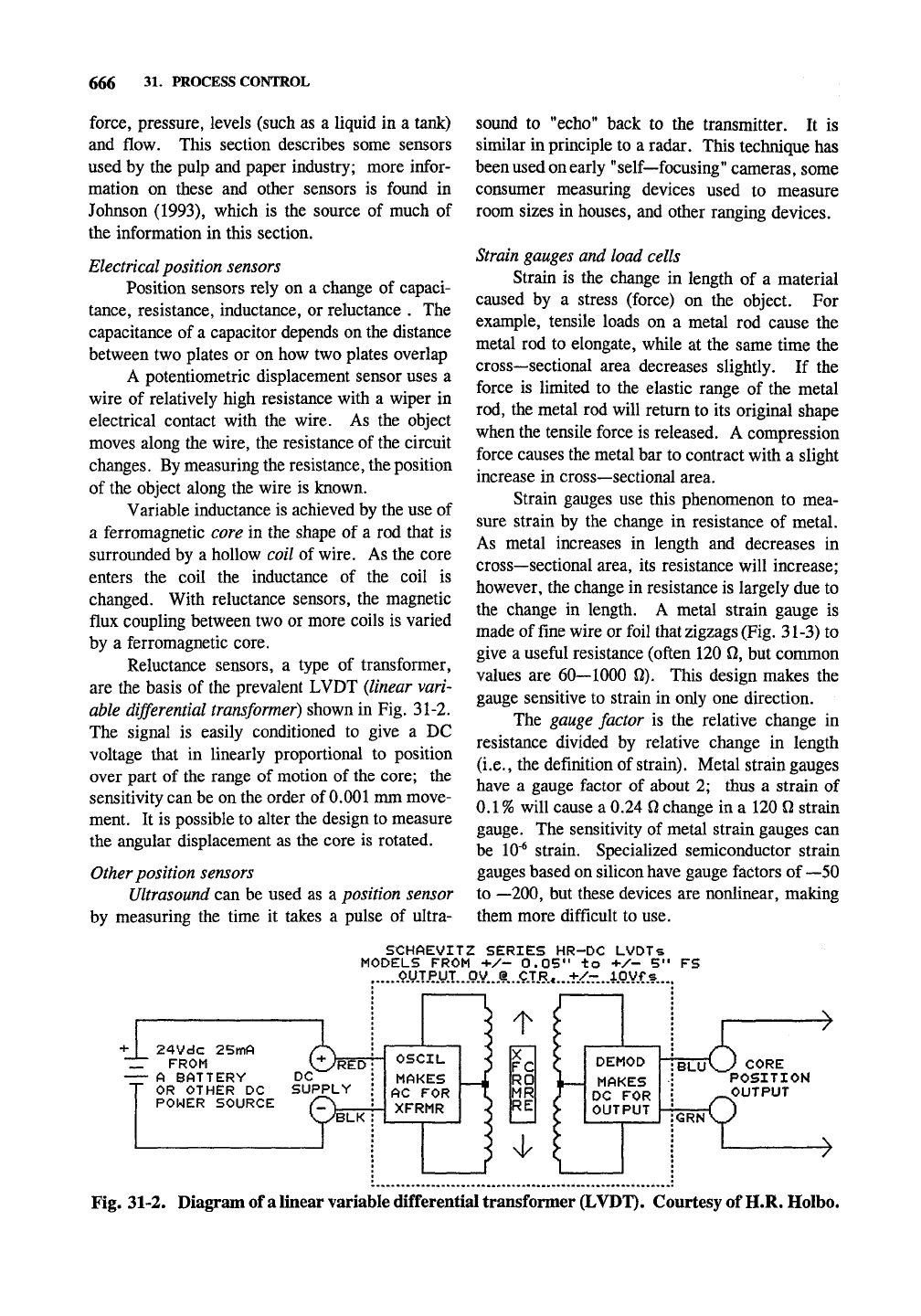
666 31. PROCESS CONTROL
force, pressure, levels (such as a liquid in a tank)
and flow. This section describes some sensors
used by the pulp and paper industry; more infor-
mation on these and other sensors is found in
Johnson (1993), which is the source of much of
the information in this section.
Electrical position sensors
Position sensors rely on a change of capaci-
tance, resistance, inductance, or reluctance . The
capacitance of a capacitor depends on the distance
between two plates or on how two plates overlap
A potentiometric displacement sensor uses a
wire of relatively high resistance with a wiper in
electrical contact with the wire. As the object
moves along the wire, the resistance of the circuit
changes. By measuring the resistance, the position
of the object along the wire is known.
Variable inductance is achieved by the use of
a ferromagnetic core in the shape of a rod that is
surrounded by a hollow coil of wire. As the core
enters the coil the inductance of the coil is
changed. With reluctance sensors, the magnetic
flux coupling between two or more coils is varied
by a ferromagnetic core.
Reluctance sensors, a type of transformer,
are the basis of the prevalent LVDT (linear vari-
able differential transformer) shown in Fig. 31-2.
The signal is easily conditioned to give a DC
voltage that in linearly proportional to position
over part of the range of motion of the core; the
sensitivity can be on the order of
0.001
mm move-
ment. It is possible to alter the design to measure
the angular displacement as the core is rotated.
Other position sensors
Ultrasound can be used as a position sensor
by measuring the time it takes a pulse of ultra-
sound to "echo" back to the transmitter. It is
similar in principle to a radar. This technique has
been used on early "self—focusing" cameras, some
consumer measuring devices used to measure
room sizes in houses, and other ranging devices.
Strain gauges and load cells
Strain is the change in length of a material
caused by a stress (force) on the object. For
example, tensile loads on a metal rod cause the
metal rod to elongate, while at the same time the
cross—sectional area decreases slightly. If the
force is limited to the elastic range of the metal
rod, the metal rod will return to its original shape
when the tensile force is released. A compression
force causes the metal bar to contract with a slight
increase in cross—sectional area.
Strain gauges use this phenomenon to mea-
sure strain by the change in resistance of metal.
As metal increases in length and decreases in
cross—sectional area, its resistance will increase;
however, the change in resistance is largely due to
the change in length. A metal strain gauge is
made of fine wire or foil that zigzags
(Fig.
31-3) to
give a useful resistance (often 120 Q, but common
values are 60—1000 Q). This design makes the
gauge sensitive to strain in only one direction.
The gauge factor is the relative change in
resistance divided by relative change in length
(i.e.,
the definition of
strain).
Metal strain gauges
have a gauge factor of about 2; thus a strain of
0.1%
will cause a 0.24 0 change in a 120 Q strain
gauge. The sensitivity of metal strain gauges can
be 10'^ strain. Specialized semiconductor strain
gauges based on silicon have gauge factors of —50
to —200, but these devices are nonlinear, making
them more difficult to use.
24Vdc 25mA
FROM
A BATTERY
OR OTHER DC
POWER SOURCE
SCHAEVITZ SERIES HR~DC LVDTs
MODELS FROM +/- 0.05" to +/- 5" FS
OUTPUT OV e CTR« +/- lOVfs
LyBLK"
DC
’
’
SUPPLY
OSCIL
MAKES
AC FOR
XFRMR
t
X
FC
RO
MR
RE
4-
DEMOD
MAKES
DC FOR
OUTPUT
:BLU
:GRN
6.
CORE
POSITION
OUTPUT
Fig. 31-2. Diagram of a linear variable differential transformer (LVDT). Courtesy of H.R. Holbo.
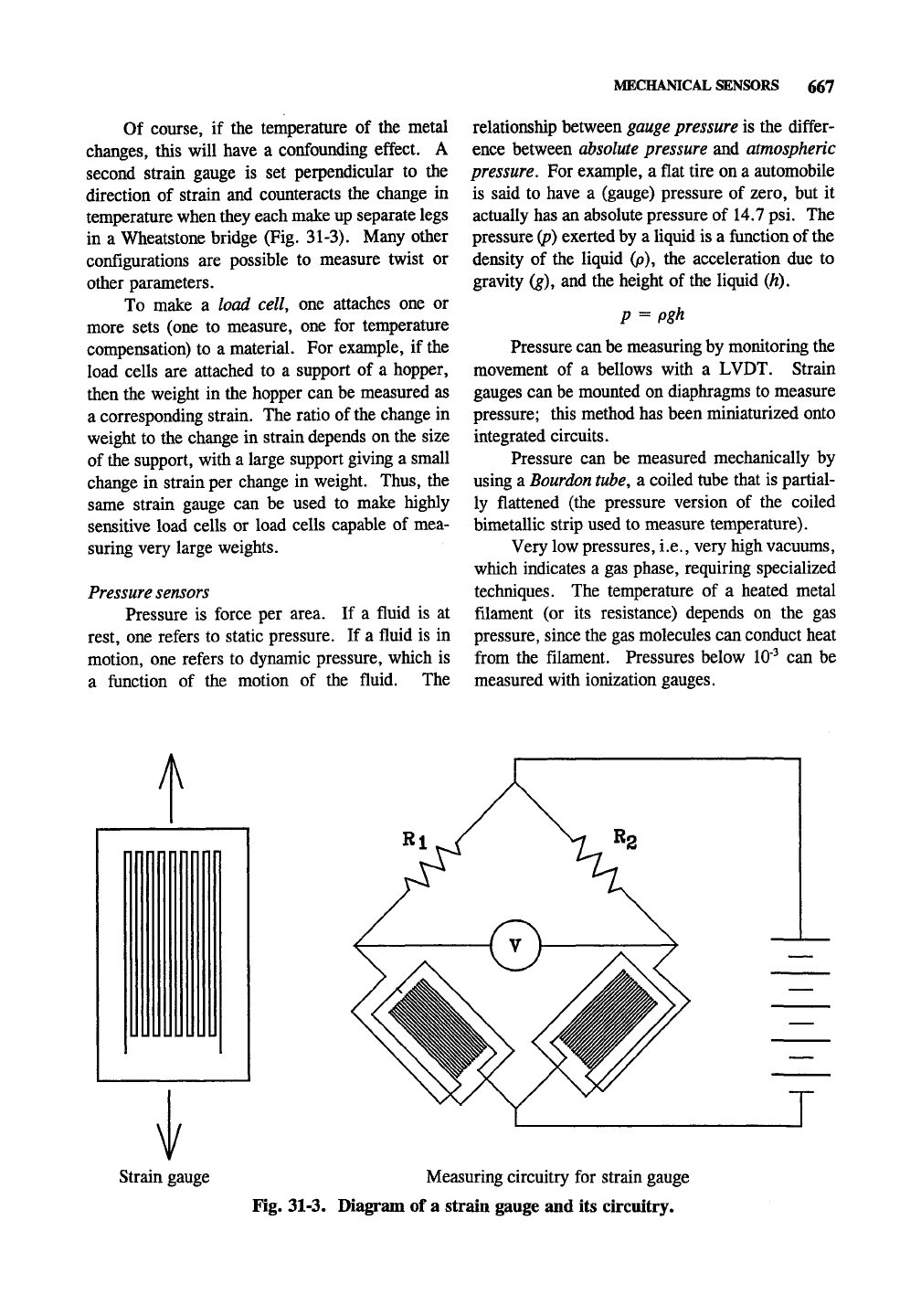
MECHANICAL SENSORS 667
Of course, if the temperature of the metal
changes, this will have a confounding effect. A
second strain gauge is set perpendicular to the
direction of strain and counteracts the change in
temperature when they each make up separate legs
in a Wheatstone bridge (Fig. 31-3). Many other
configurations are possible to measure twist or
other parameters.
To make a load
cell,
one attaches one or
more sets (one to measure, one for temperature
compensation) to a material. For example, if the
load cells are attached to a support of a hopper,
then the weight in the hopper can be measured as
a corresponding strain. The ratio of the change in
weight to the change in strain depends on the size
of the support, with a large support giving a small
change in strain per change in weight. Thus, the
same strain gauge can be used to make highly
sensitive load cells or load cells capable of mea-
suring very large weights.
Pressure sensors
Pressure is force per area. If a fluid is at
rest, one refers to static pressure. If a fluid is in
motion, one refers to dynamic pressure, which is
a function of the motion of the fluid. The
relationship between gauge pressure is the differ-
ence between absolute pressure and atmospheric
pressure. For example, a flat tire on a automobile
is said to have a (gauge) pressure of zero, but it
actually has an absolute pressure of 14.7 psi. The
pressure ip) exerted by a liquid is a function of the
density of the liquid (p), the acceleration due to
gravity (g), and the height of the liquid {h),
P = Pgh
Pressure can be measuring by monitoring the
movement of a bellows with a LVDT. Strain
gauges can be mounted on diaphragms to measure
pressure; this method has been miniaturized onto
integrated circuits.
Pressure can be measured mechanically by
using a
Bourdon
tube, a coiled tube that is partial-
ly flattened (the pressure version of the coiled
bimetallic strip used to measure temperature).
Very low pressures, i.e., very high vacuums,
which indicates a gas phase, requiring specialized
techniques. The temperature of a heated metal
filament (or its resistance) depends on the gas
pressure, since the gas molecules can conduct heat
from the filament. Pressures below 10"^ can be
measured with ionization gauges.
Strain gauge Measuring circuitry for strain gauge
Fig. 31-3. Diagram of a strain gauge and its circuitry.
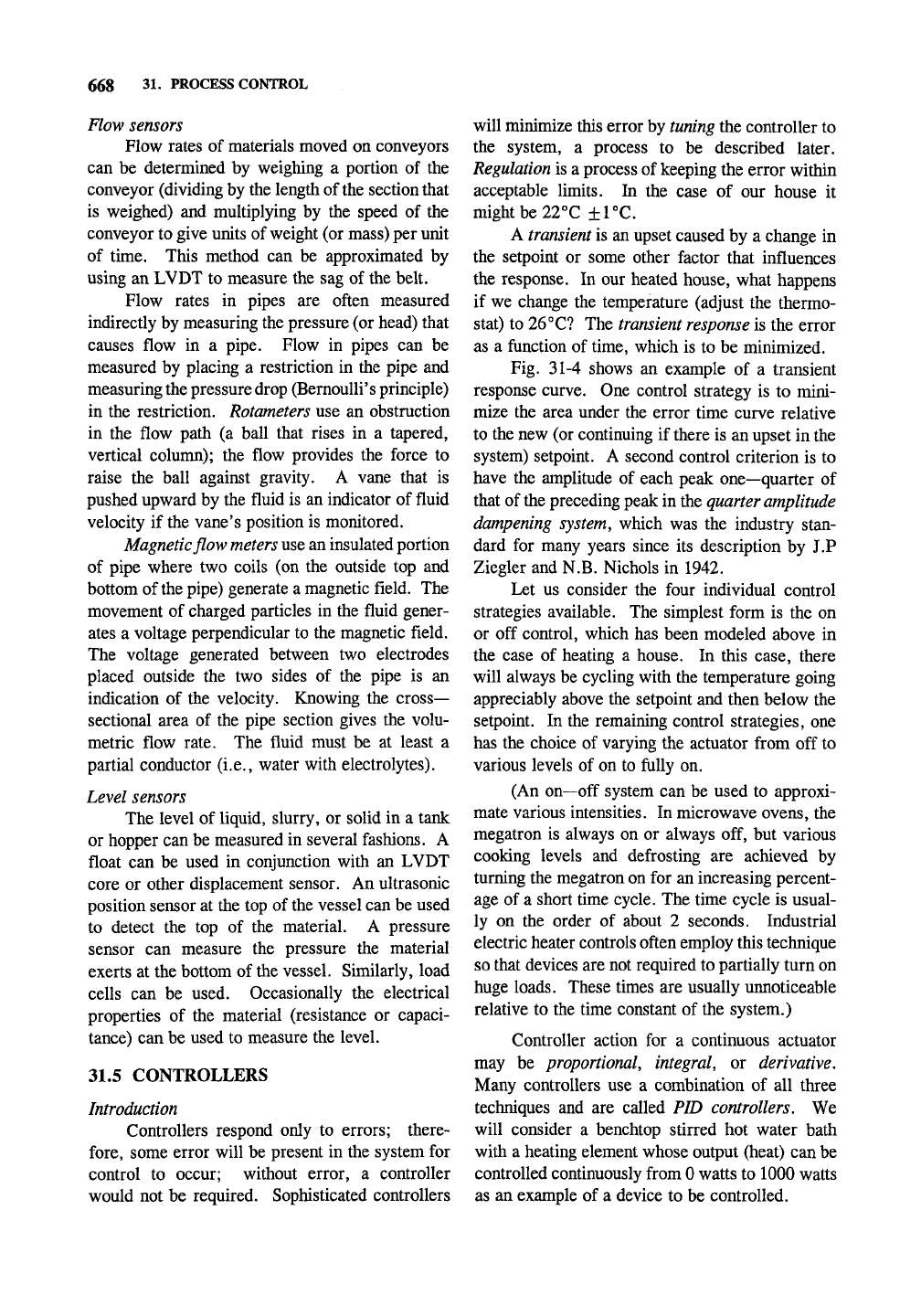
668 31. PROCESS CONTROL
Flow sensors
Flow rates of materials moved on conveyors
can be determined by weighing a portion of the
conveyor (dividing by the length of
the
section that
is weighed) and multiplying by the speed of the
conveyor to give units of weight (or mass) per unit
of time. This method can be approximated by
using an LVDT to measure the sag of the belt.
Flow rates in pipes are often measured
indirectly by measuring the pressure (or head) that
causes flow in a pipe. Flow in pipes can be
measured by placing a restriction in the pipe and
measuring the pressure drop (Bernoulli's principle)
in the restriction. Rotameters use an obstruction
in the flow path (a ball that rises in a tapered,
vertical column); the flow provides the force to
raise the ball against gravity. A vane that is
pushed upward by the fluid is an indicator of fluid
velocity if the vane's position is monitored.
Magnetic flow
meters
use an insulated portion
of pipe where two coils (on the outside top and
bottom of the pipe) generate a magnetic field. The
movement of charged particles in the fluid gener-
ates a voltage perpendicular to the magnetic field.
The voltage generated between two electrodes
placed outside the two sides of the pipe is an
indication of the velocity. Knowing the cross-
sectional area of the pipe section gives the volu-
metric flow rate. The fluid must be at least a
partial conductor (i.e., water with electrolytes).
Level sensors
The level of liquid, slurry, or solid in a tank
or hopper can be measured in several fashions. A
float can be used in conjunction with an LVDT
core or other displacement sensor. An ultrasonic
position sensor at the top of the vessel can be used
to detect the top of the material. A pressure
sensor can measure the pressure the material
exerts at the bottom of the vessel. Similarly, load
cells can be used. Occasionally the electrical
properties of the material (resistance or capaci-
tance) can be used to measure the level.
31.5 CONTROLLERS
Introduction
Controllers respond only to errors; there-
fore,
some error will be present in the system for
control to occur; without error, a controller
would not be required. Sophisticated controllers
will minimize this error by tuning the controller to
the system, a process to be described later.
Regulation is a process of keeping the error within
acceptable limits. In the case of our house it
might be 22°C ±1°C.
A transient is an upset caused by a change in
the setpoint or some other factor that influences
the response. In our heated house, what happens
if we change the temperature (adjust the thermo-
stat) to 26 °C? The transient response is the error
as a function of time, which is to be minimized.
Fig. 31-4 shows an example of a transient
response curve. One control strategy is to mini-
mize the area under the error time curve relative
to the new (or continuing if there is an upset in the
system) setpoint. A second control criterion is to
have the amplitude of each peak one—quarter of
that of
the
preceding peak in the
quarter amplitude
dampening system, which was the industry stan-
dard for many years since its description by J.P
Ziegler and N.B. Nichols in 1942.
Let us consider the four individual control
strategies available. The simplest form is the on
or off control, which has been modeled above in
the case of heating a house. In this case, there
will always be cycling with the temperature going
appreciably above the setpoint and then below the
setpoint. In the remaining control strategies, one
has the choice of varying the actuator from off to
various levels of on to fully on.
(An on—off system can be used to approxi-
mate various intensities. In microwave ovens, the
megatron is always on or always off, but various
cooking levels and defrosting are achieved by
turning the megatron on for an increasing percent-
age of a short time cycle. The time cycle is usual-
ly on the order of about 2 seconds. Industrial
electric heater controls often employ this technique
so that devices are not required to partially turn on
huge loads. These times are usually urmoticeable
relative to the time constant of the system.)
Controller action for a continuous actuator
may be proportional, integral, or derivative.
Many controllers use a combination of all three
techniques and are called PID controllers. We
will consider a benchtop stirred hot water bath
with a heating element whose output (heat) can be
controlled continuously from 0 watts to 1000 watts
as an example of a device to be controlled.
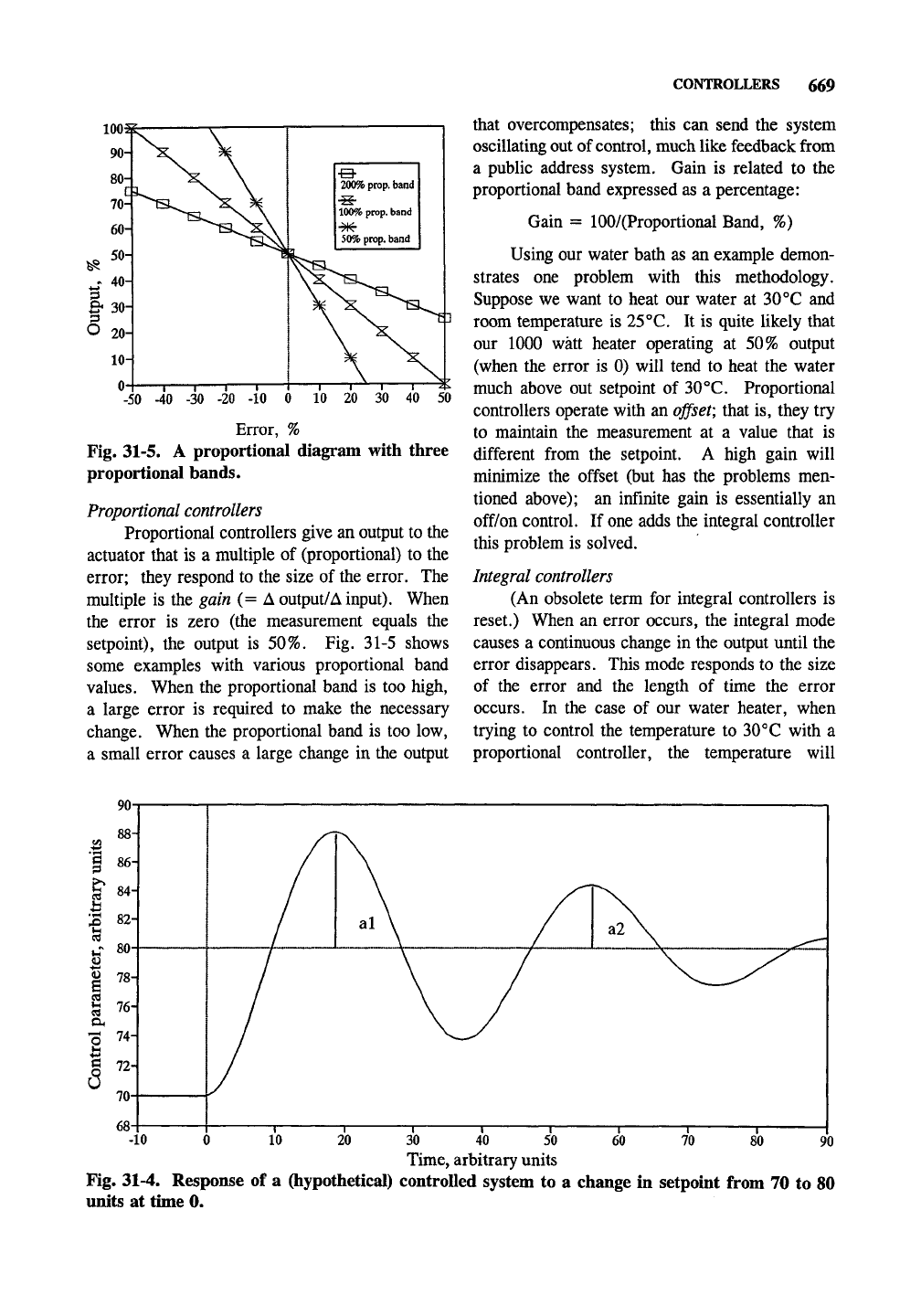
CONTROLLERS 669
200% prop, band
100% prop, band
"^
50% prop, band
1 \ 1 1 1 1 r
50 -40 -30 -20 -10 0 10 20 30 40 50
Error, %
Fig. 31-5. A proportional diagram with three
proportional bands.
Proportional controllers
Proportional controllers give an output to the
actuator that is a multiple of (proportional) to the
error; they respond to the size of the error. The
multiple is the gain (= A output/A input). When
the error is zero (the measurement equals the
setpoint), the output is 50%. Fig. 31-5 shows
some examples with various proportional band
values. When the proportional band is too high,
a large error is required to make the necessary
change. When the proportional band is too low,
a small error causes a large change in the output
that overcompensates; this can send the system
oscillating out of control, much like feedback from
a public address system. Gain is related to the
proportional band expressed as a percentage:
Gain = 100/(Proportional Band, %)
Using our water bath as an example demon-
strates one problem with this methodology.
Suppose we want to heat our water at 30°C and
room temperature is 25
°C.
It is quite likely that
our 1000 watt heater operating at 50% output
(when the error is 0) will tend to heat the water
much above out setpoint of 30
°C.
Proportional
controllers operate with an
offset;
that is, they try
to maintain the measurement at a value that is
different from the setpoint. A high gain will
minimize the offset (but has the problems men-
tioned above); an infinite gain is essentially an
off/on control. If one adds the integral controller
this problem is solved.
Integral controllers
(An obsolete term for integral controllers is
reset.) When an error occurs, the integral mode
causes a continuous change in the output until the
error disappears. This mode responds to the size
of the error and the length of time the error
occurs. In the case of our water heater, when
trying to control the temperature to 30°C with a
proportional controller, the temperature will
80
90
30 40 50
Time, arbitrary units
Fig. 31-4. Response of a (hypothetical) controlled system to a change in setpoint from 70 to 80
units at time 0.

670 31. PROCESS CONTROL
consistently overshoot the mark. The integral
mode would step in and continuously lower the
offset until the temperature goes below 30°C,
which might be a power level of 20%. The
curves in Fig. 31-5 would be in effect, except that
they would intersect at 20% output for this device
operating at this temperature.
The effect of integral controllers is measured
in units of minutes per repeat or its reciprocal. A
high nimiber of minutes per repeat indicates a low
action by the integral controller.
Derivative controllers
Derivative controllers respond to the change
in error with time. If the absolute value of error
is rapidly decreasing and the setpoint is near, it is
likely that the setpoint will be reached and the
error will change sign and increase in the other
direction. The derivative mode is useful in pre-
venting this situation, especially in systems with
large time constants. Derivative response is
usually measured in minutes; the time is a mea-
sure of how far ahead the derivative -h proportion-
al action is ahead of the proportional action only
in an open loop; the higher this value, the greater
the derivative action..
Since a spike (a large, but brief response in
the measured value) would cause a large action by
the derivative mode, where no action is appro-
priate, the derivative mode is not always appropri-
ate.
This is true with signals that are inherently
noisy (such as flow rate measurements) or systems
with long dead times. Sometimes the derivative
mode is only used when a change in setpoint
occurs. The derivative mode us usually well
suited for temperature measurements and control.
PID controllers
Proportional—plus—integral—plus—derivative
controllers are described (Anderson, 1980) as:
m
•-2\e + — fedt + D —
^\ RJ dt
where
D =
e =
g =
m =
R =
t =
derivative time
error
gain
controller output (0-
integral time
time
-100%)
31.6 ACTUATORS
Once the sensors determine the status and
once the controller determines what action is
required, actuators carry out the appropriate
response. Actuators take the result of control
signals and cause a change on the control element.
They are not the control elements. The term
actuators seems to imply movement, but that is not
always the case. An actuator may be an electronic
relay (such as a silicon—controlled rectifier, SCR)
that switches power to the control element.
Solenoids convert an electrical current into a
relatively small back and forth motion. When a
coil is energized, a metal plunger is drawn into it.
A spring may be used to return the plunger to its
original position. Motors convert electric signals
into rotary motion. Motors are, in turn, used for
movement, pumping of fluids, valve positions, etc.
Motors can also be driven by air (pneumatic) or
hydraulic fluid. Pneumatic actuators convert air
pressure into movement. Actuators designed for
valves are discussed on page 655.
31.7 ANNOTATED BIBLIOGRAPHY
1.
Anderson,
N.
A., Instrumentation for Process
Measurement and Control, 3rd ed., Chilton
Co.,
Radnor, Penn., 1980, 498 p. This
work is useful for controller theory.
2.
Johnson, C.,
Process
Control Instrumentation
Technology, 4th ed., Regents/Prentice—Hall
Englewood Cliffs, New Jersey, 1993, 592 p.
The work is up to date and a good overall
reference on the topic. It includes analog
and digital signal conditioning, thermal,
mechanical, and optical sensors, process con-
trol, actuators, and controllers. A later
edition is available.
3.
Omega, The Temperature Handbook, The
Data
Acquisition
Systems, pH and
Conductiv-
ity, Pressure and Strain, Heaters, and Flow
and
Level,
This is a series of catalogs by the
Omega Technology
Co.
(Stamford, Connecti-
cut) of products they sell; however, these
substantial catalogs (available at no charge)
contain invaluable practical information and
tutorials. Every mill engineering library
should have a set of these books.
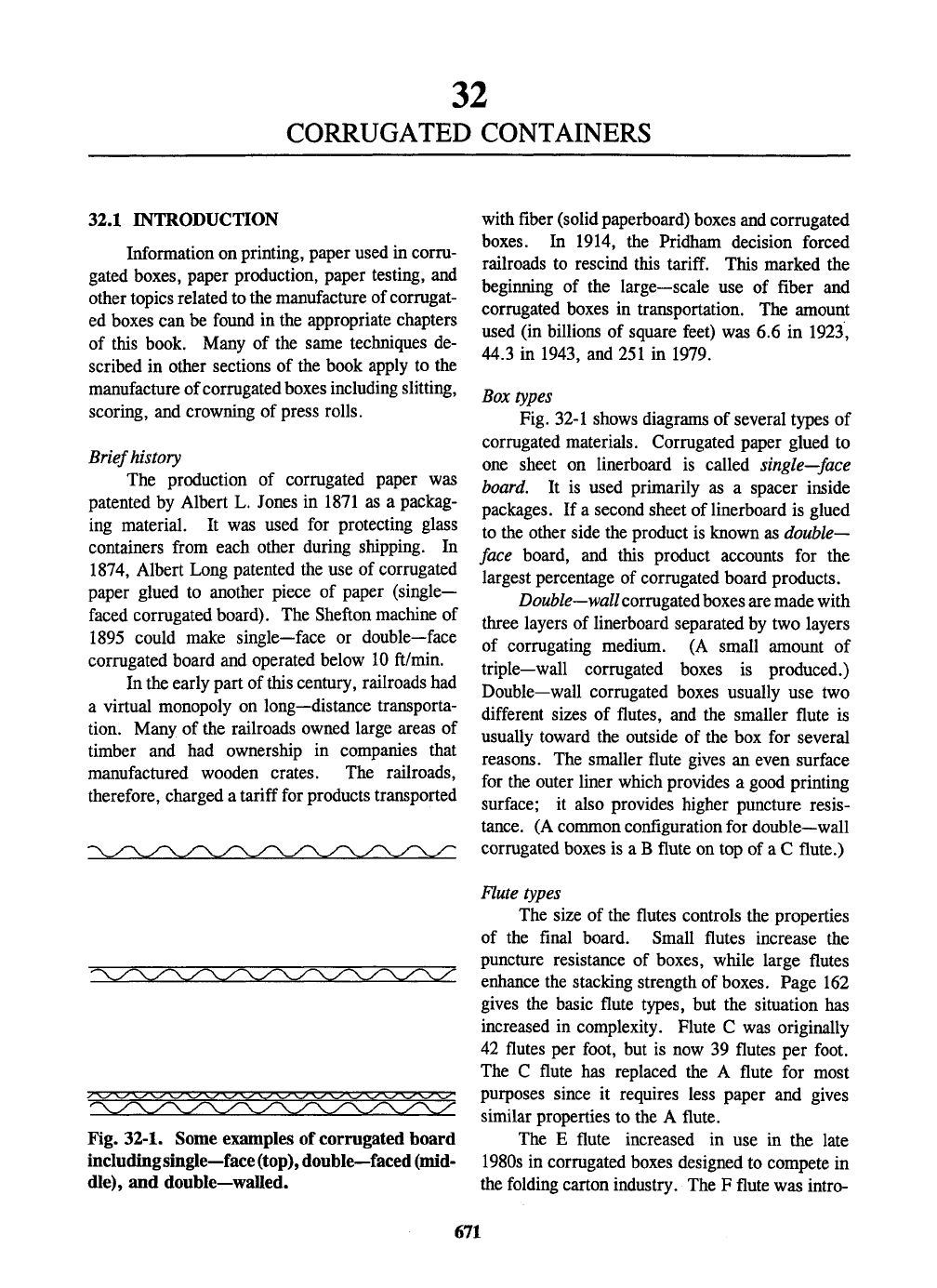
32
CORRUGATED CONTAINERS
32.1 INTRODUCTION
Information on printing, paper used in corru-
gated boxes, paper production, paper testing, and
other topics related to the manufacture of corrugat-
ed boxes can be found in the appropriate chapters
of this book. Many of the same techniques de-
scribed in other sections of the book apply to the
manufacture of corrugated
boxes
including slitting,
scoring, and crowning of press rolls.
Brief history
The production of corrugated paper was
patented by Albert L. Jones in 1871 as a packag-
ing material. It was used for protecting glass
containers from each other during shipping. In
1874,
Albert Long patented the use of corrugated
paper glued to another piece of paper (single-
faced corrugated board). The Shefton machine of
1895 could make single—face or double—face
corrugated board and operated below 10 ft/min.
In the early part of
this
century, railroads had
a virtual monopoly on long—distance transporta-
tion. Many of the railroads owned large areas of
timber and had ownership in companies that
manufactured wooden crates. The railroads,
therefore, charged a tariff for products transported
Fig. 32-1. Some examples of corrugated board
including single—face
(top),
double—faced (mid-
dle),
and double—walled.
with fiber (solid paperboard) boxes and corrugated
boxes.
In 1914, the Pridham decision forced
railroads to rescind this
tariff.
This marked the
beginning of the large—scale use of fiber and
corrugated boxes in transportation. The amount
used (in billions of square feet) was 6.6 in 1923,
44.3 in 1943, and 251 in 1979.
Box types
Fig. 32-1 shows diagrams of several types of
corrugated materials. Corrugated paper glued to
one sheet on linerboard is called single—face
board.
It is used primarily as a spacer inside
packages. If a second sheet of linerboard is glued
to the other side the product is known as double—
face board, and this product accounts for the
largest percentage of corrugated board products.
Double—wall corrugated
boxes
are made with
three layers of linerboard separated by two layers
of corrugating medium. (A small amount of
triple—wall corrugated boxes is produced.)
Double—wall corrugated boxes usually use two
different sizes of flutes, and the smaller flute is
usually toward the outside of the box for several
reasons. The smaller flute gives an even surface
for the outer liner which provides a good printing
surface; it also provides higher puncture resis-
tance. (A common configuration for double—wall
corrugated boxes is a B flute on top of a C flute.)
Flute types
The size of the flutes controls the properties
of the final board. Small flutes increase the
puncture resistance of boxes, while large flutes
enhance the stacking strength of boxes. Page 162
gives the basic flute types, but the situation has
increased in complexity. Flute C was originally
42 flutes per foot, but is now 39 flutes per foot.
The C flute has replaced the A flute for most
purposes since it requires less paper and gives
similar properties to the A flute.
The E flute increased in use in the late
1980s in corrugated boxes designed to compete in
the folding carton industry. The F flute was intro-
671
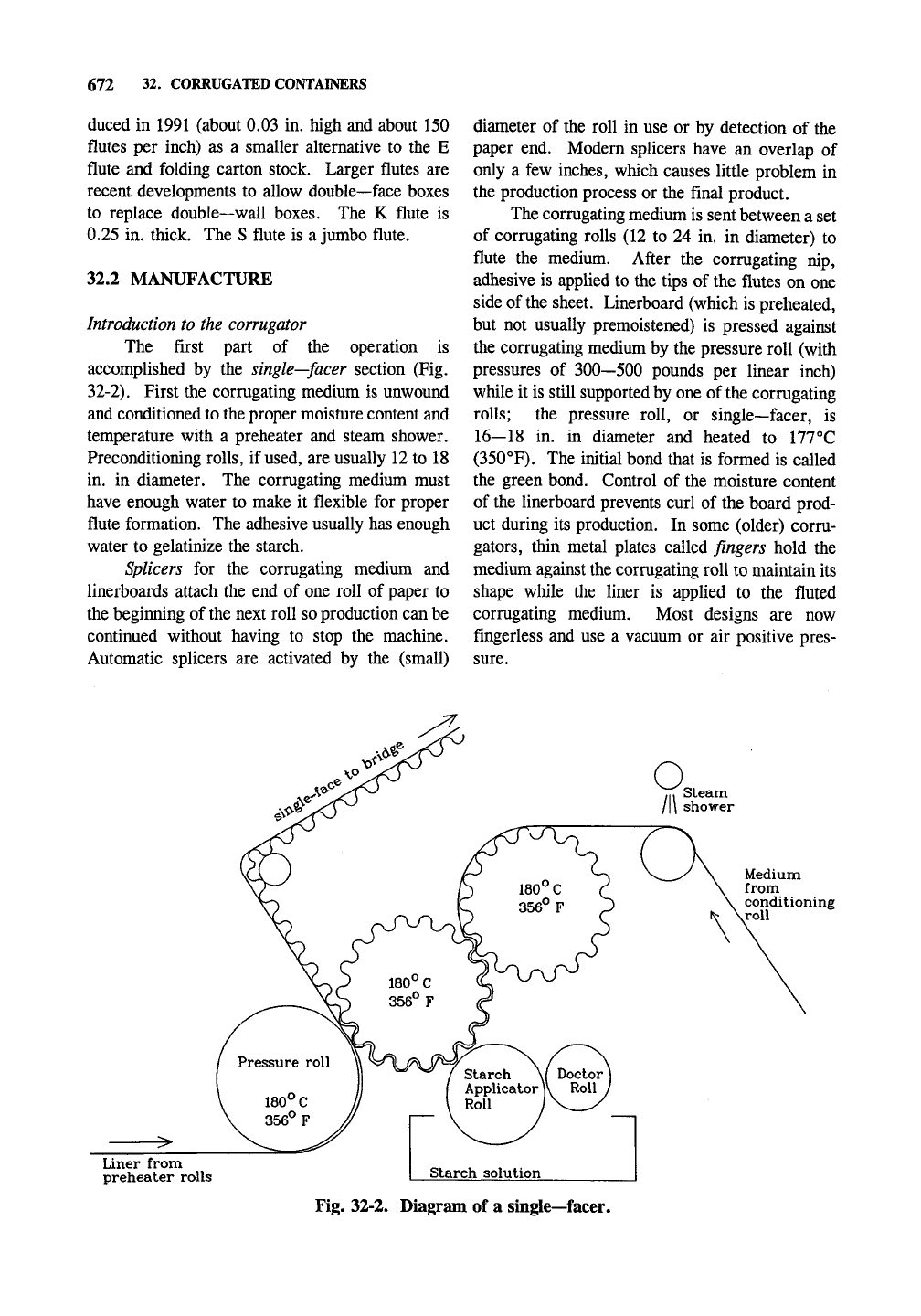
672 32. CORRUGATED CONTAINERS
duced in 1991 (about 0.03 in. high and about 150
flutes per inch) as a smaller alternative to the E
flute and folding carton stock. Larger flutes are
recent developments to allow double—face boxes
to replace double—wall boxes. The K flute is
0.25 in. thick. The S flute is a jumbo flute.
32.2 MANUFACTURE
Introduction to the corrugator
The first part of the operation is
accomplished by the single—facer section (Fig.
32-2).
First the corrugating medium is unwound
and conditioned to the proper moisture content and
temperature with a preheater and steam shower.
Preconditioning rolls, if used, are usually 12 to 18
in. in diameter. The corrugating medium must
have enough water to make it flexible for proper
flute formation. The adhesive usually has enough
water to gelatinize the starch.
Splicers for the corrugating medium and
linerboards attach the end of one roll of paper to
the beginning of the next roll so production can be
continued without having to stop the machine.
Automatic splicers are activated by the (small)
diameter of the roll in use or by detection of the
paper end. Modern splicers have an overlap of
only a few inches, which causes little problem in
the production process or the final product.
The corrugating medium is sent between a set
of corrugating rolls (12 to 24 in. in diameter) to
flute the medium. After the corrugating nip,
adhesive is applied to the tips of the flutes on one
side of the sheet. Linerboard (which is preheated,
but not usually premoistened) is pressed against
the corrugating medium by the pressure roll (with
pressures of 300—500 pounds per linear inch)
while it is still supported by one of
the
corrugating
rolls;
the pressure roll, or single—facer, is
16—18 in. in diameter and heated to 177°C
(350°F). The initial bond that is formed is called
the green bond. Control of the moisture content
of the linerboard prevents curl of the board prod-
uct during its production. In some (older) corru-
gators, thin metal plates called fingers hold the
medium against the corrugating roll to maintain its
shape while the liner is applied to the fluted
corrugating medium. Most designs are now
fingerless and use a vacuum or air positive pres-
sure.
... steam
/|\ shower
Medium
from
conditioning
roU
Liner from
preheater rolls
Fig. 32-2. Diagram of a single—facer.
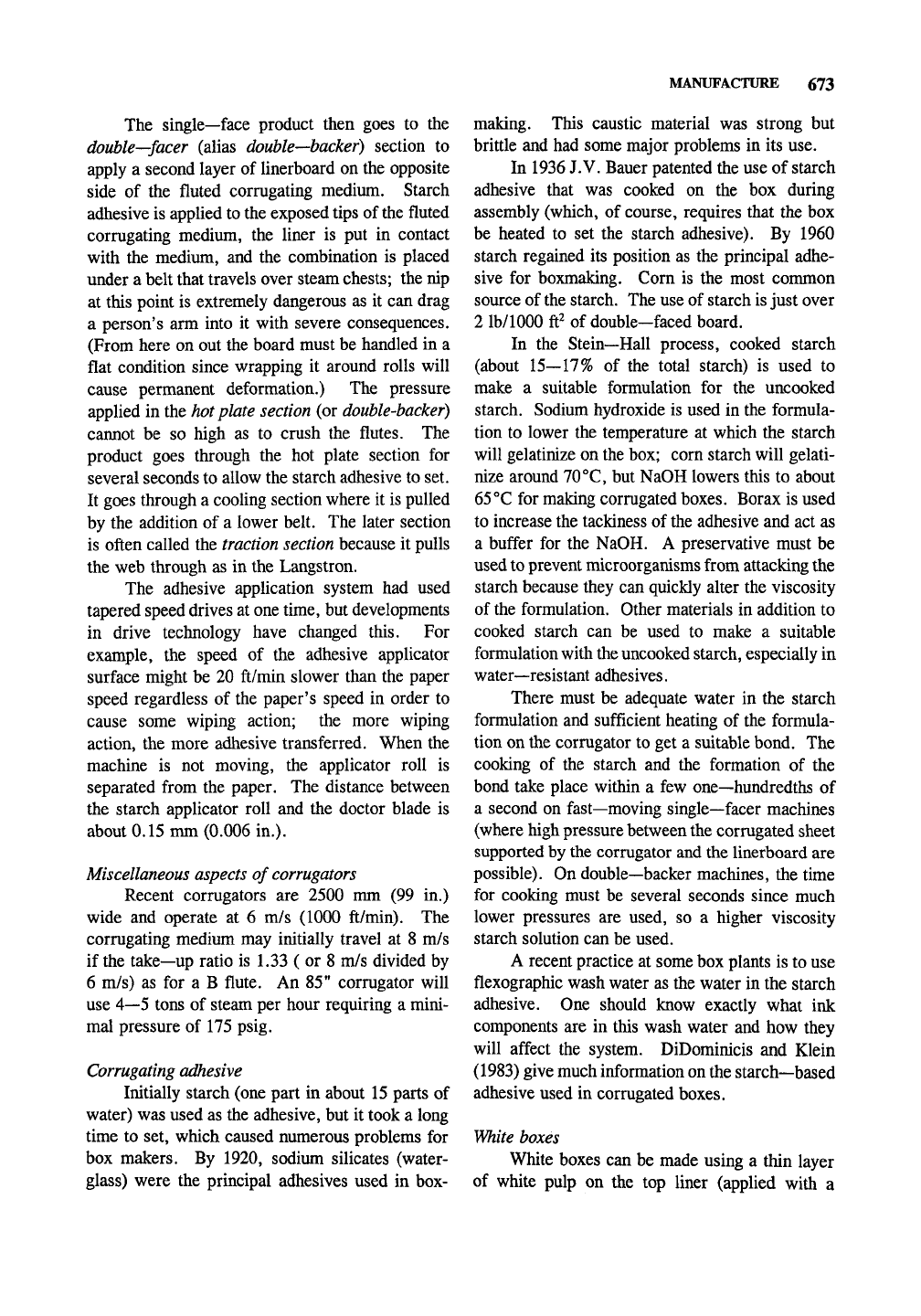
MANUFACTURE 673
The single—face product then goes to the
double—facer (alias double—backer) section to
apply a second layer of linerboard on the opposite
side of the fluted corrugating medium. Starch
adhesive is applied to the exposed tips of the fluted
corrugating medium, the liner is put in contact
with the medium, and the combination is placed
under a belt that travels over steam chests; the nip
at this point is extremely dangerous as it can drag
a person's arm into it with severe consequences.
(From here on out the board must be handled in a
flat condition since wrapping it around rolls will
cause permanent deformation.) The pressure
applied in the hotplate section (or double-backer)
cannot be so high as to crush the flutes. The
product goes through the hot plate section for
several seconds to allow the starch adhesive to set.
It goes through a cooling section where it is pulled
by the addition of a lower belt. The later section
is often called the traction section because it pulls
the web through as in the Langstron.
The adhesive application system had used
tapered speed drives at one time, but developments
in drive technology have changed this. For
example, the speed of the adhesive applicator
surface might be 20 ft/min slower than the paper
speed regardless of the paper's speed in order to
cause some wiping action; the more wiping
action, the more adhesive transferred. When the
machine is not moving, the applicator roll is
separated from the paper. The distance between
the starch applicator roll and the doctor blade is
about 0.15 mm (0.006 in.).
Miscellaneous aspects of
corrugators
Recent corrugators are 2500 mm (99 in.)
wide and operate at 6 m/s (1000 ft/min). The
corrugating medium may initially travel at 8 m/s
if the take—up ratio is 1.33 ( or 8 m/s divided by
6 m/s) as for a B flute. An 85" corrugator will
use 4—5 tons of steam per hour requiring a mini-
mal pressure of 175 psig.
Corrugating
adhesive
Initially starch (one part in about 15 parts of
water) was used as the adhesive, but it took a long
time to set, which caused numerous problems for
box makers. By 1920, sodium silicates (water-
glass) were the principal adhesives used in box-
making. This caustic material was strong but
brittle and had some major problems in its use.
In 1936 J. V. Bauer patented the use of starch
adhesive that was cooked on the box during
assembly (which, of course, requires that the box
be heated to set the starch adhesive). By 1960
starch regained its position as the principal adhe-
sive for boxmaking. Corn is the most common
source of the starch. The use of starch
is
just over
2 lb/1000 ft2 of double—faced board.
In the Stein—Hall process, cooked starch
(about 15—17% of the total starch) is used to
make a suitable formulation for the uncooked
starch. Sodium hydroxide is used in the formula-
tion to lower the temperature at which the starch
will gelatinize on the box; corn starch will gelati-
nize around 70°C, but NaOH lowers this to about
65°C for making corrugated boxes. Borax is used
to increase the tackiness of the adhesive and act as
a buffer for the NaOH. A preservative must be
used to prevent microorganisms from attacking the
starch because they can quickly alter the viscosity
of the formulation. Other materials in addition to
cooked starch can be used to make a suitable
formulation with the uncooked starch, especially in
water—resistant adhesives.
There must be adequate water in the starch
formulation and sufficient heating of the formula-
tion on the corrugator to get a suitable bond. The
cooking of the starch and the formation of the
bond take place within a few one—hundredths of
a second on fast—moving single—facer machines
(where high pressure between the corrugated sheet
supported by the corrugator and the linerboard are
possible). On double—backer machines, the time
for cooking must be several seconds since much
lower pressures are used, so a higher viscosity
starch solution can be used.
A recent practice at some box plants is to use
flexographic wash water as the water in the starch
adhesive. One should know exactly what ink
components are in this wash water and how they
will affect the system. DiDominicis and Klein
(1983) give much information on the starch—based
adhesive used in corrugated boxes.
Wiite boxes
White boxes can be made using a thin layer
of white pulp on the top liner (applied with a
